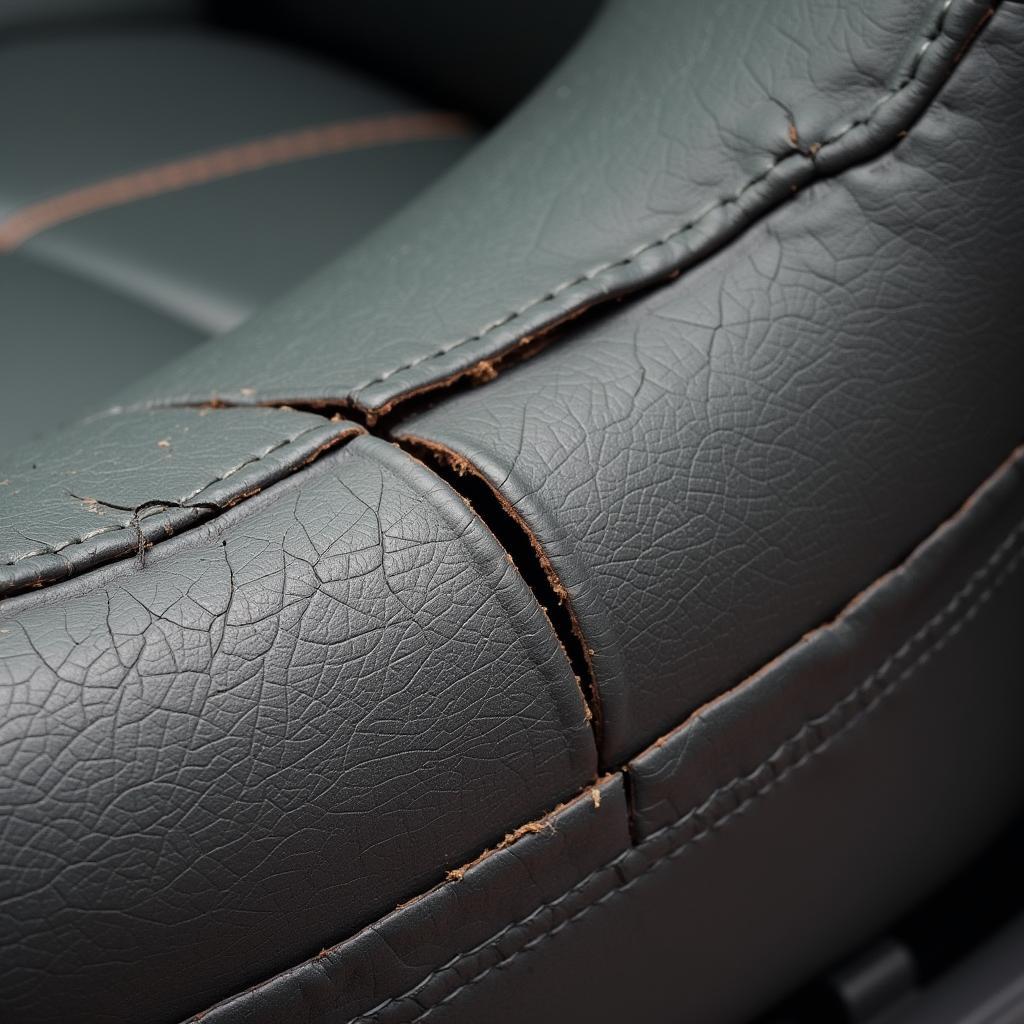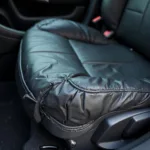A cracked car seat can make your car’s interior look worn and detract from its overall value. While you might think a professional repair is the only solution, there are actually ways to address this issue yourself. This comprehensive guide will explore the steps involved in repairing a cracked car seat, giving you the knowledge and confidence to tackle the project head-on.
Understanding the Different Types of Car Seat Damage
Before diving into the repair process, it’s crucial to identify the type of damage your car seat has sustained. This will determine the best course of action for repair.
- Cracks: These are linear splits in the seat material, often caused by wear and tear, sun damage, or sharp objects.
- Tears: Unlike cracks, tears are jagged and uneven, usually resulting from forceful impacts or accidents.
- Holes: These are complete openings in the seat material, often caused by burns, sharp objects, or extensive wear.
- Scuffs and Scratches: These are superficial marks on the surface of the material, often caused by friction or contact with abrasive objects.
Essential Materials for Car Seat Repair
Having the right tools and materials at your disposal will make the repair process smoother and more effective. Here’s what you’ll need:
- Cleaning Supplies: Leather cleaner (for leather seats), vinyl cleaner (for vinyl seats), microfiber cloths, rubbing alcohol.
- Repair Compound: Leather filler (for leather seats), vinyl repair kit (for vinyl seats).
- Colorant/Dye: Leather dye (for leather seats), vinyl dye (for vinyl seats).
- Applicators: Spatula, foam brush, cotton swabs, sandpaper (various grits).
- Finishing Touches: Leather conditioner (for leather seats), vinyl protectant (for vinyl seats).
Pro Tip from John Miller, Automotive Upholstery Expert: Always test the cleaning products and repair compounds on a hidden area of your car seat before applying them to the visible damage. This will help you avoid any unwanted reactions or color discrepancies.
Step-by-Step Guide to Repairing a Cracked Car Seat
Follow these steps to effectively repair a cracked car seat:
- Clean the Area: Thoroughly clean the damaged area and the surrounding surface using the appropriate cleaner for your seat material. This removes dirt, grime, and debris that can hinder the repair process.
- Prepare the Crack: Gently sand down any raised edges or loose material around the crack using fine-grit sandpaper. Wipe away any dust with a clean microfiber cloth.
- Apply the Repair Compound: Using a spatula or your finger (wearing gloves), carefully apply the leather filler or vinyl repair compound to the crack. Overfill the crack slightly to allow for shrinkage during drying.
- Level and Smooth the Surface: Allow the repair compound to dry completely according to the manufacturer’s instructions. Once dry, use sandpaper (gradually increasing grit) to level and smooth the repaired area, blending it seamlessly with the surrounding material.
- Apply Colorant/Dye (if necessary): If the crack has removed color from the seat material, use a matching colorant or dye to restore the original shade. Apply thin, even coats, allowing each coat to dry completely before applying the next.
- Apply a Protective Finish: Once the colorant/dye is dry, apply a leather conditioner or vinyl protectant to the repaired area and the surrounding seat surface. This helps protect the material from future damage and keeps it looking its best.
Tips for a Successful Car Seat Repair
Keep these tips in mind to achieve the best possible results:
- Patience is Key: Take your time with each step of the repair process, allowing ample drying time for all materials. Rushing can lead to subpar results.
- Matching Color is Crucial: When choosing a colorant or dye, aim for an exact match with your car seat’s original color. This will ensure a seamless and professional-looking repair.
- Less is More: When applying repair compounds and colorants, start with small amounts and gradually add more if needed. Over-application can be difficult to correct.
Pro Tip from John Miller, Automotive Upholstery Expert: To ensure the longevity of your repair, consider using a heat gun or hairdryer (on low heat) to help the repair compound cure faster and create a stronger bond with the seat material.
When to Consult a Professional
While DIY car seat repairs can be effective for minor damage, certain situations warrant the expertise of a professional:
- Extensive Damage: If the damage to your car seat is extensive, such as large tears, deep holes, or damage to the seat’s structural components, it’s best to consult a professional upholsterer.
- Airbag Concerns: If the damage is located near an airbag seam or deployment zone, attempting a DIY repair could compromise the airbag’s functionality. It’s crucial to consult a professional in such cases.
Conclusion
Repairing a cracked car seat can be a rewarding DIY project, saving you money and restoring your car’s interior to its former glory. By following the steps outlined in this guide and arming yourself with the right materials and a healthy dose of patience, you can achieve professional-looking results. However, remember that severe damage is best left to the experts. Whether you choose to tackle the repair yourself or seek professional assistance, addressing a cracked car seat promptly will keep your car looking its best and maintain its value for years to come.
FAQs about Cracked Car Seat Repair
Can I repair a cracked car seat with super glue?
Using super glue is not recommended for repairing car seats as it can create a stiff and inflexible bond that’s prone to cracking again. Moreover, super glue can damage certain seat materials.
How long does it take for a leather filler to dry?
Drying times vary depending on the specific product and environmental conditions, but most leather fillers require at least 24 hours to dry completely.
Can I use shoe polish to recolor my car seat?
Shoe polish is not formulated for car seat materials and can lead to uneven color, a sticky finish, and potential damage to the seat.
Is it possible to prevent car seats from cracking?
Protecting your car seats from extreme temperatures, direct sunlight, and sharp objects can significantly reduce the risk of cracking. Regularly cleaning and conditioning your seats will also help preserve their condition.
How much does it cost to have a car seat professionally repaired?
The cost of professional car seat repair depends on the severity of the damage, the type of material, and the location. It’s best to contact local upholstery shops for accurate quotes.
Need Help With Your Car Seat Repair?
If you need assistance with repairing your car seat or have any questions, feel free to contact our team of experts. We are available 24/7 to provide you with personalized guidance and support. Reach us via WhatsApp at +1(641)206-8880 or email us at [email protected].



